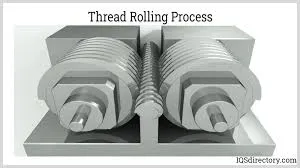Thread Rolling Machines: Pioneering the Future of Threads
Threaded fasteners are ubiquitous in our modern world, holding together everything from the smartphones we use daily to the massive structures that define our cities. These threads are essential, and their quality and durability are paramount. One revolutionary technology that has been instrumental in enhancing the quality and efficiency of thread production is the Thread Rolling Machine. In this article, we’ll delve into the world of thread rolling machines, exploring their history, working principles, applications, and their role in pioneering the future of threads.
The Genesis of Thread Rolling Machines
Before the advent of thread rolling machines, threads were primarily cut or machined using methods like threading dies or single-point threading on lathes. These processes were time-consuming, less precise, and generated a considerable amount of waste material. To address these shortcomings, the thread rolling machine was born.
The concept of thread rolling dates back to the early 19th century, but it was in the 20th century that thread rolling machines truly came into their own. Inventors like Edwin E. Jervis and James Cunningham developed the technology further, paving the way for the modern thread rolling machines we have today.
How Thread Rolling Machines Work
Thread rolling machines operate on a straightforward yet ingenious principle. Instead of cutting or removing material, they deform it to form threads. The process involves three essential components: the workpiece (the material being threaded), the thread rolls (two cylindrical dies with thread-shaped ridges), and the machine itself.
The operation can be summarized in the following steps:
- Feeding: The workpiece is placed between the two thread rolls, which are set to the desired thread profile.
- Rolling: The rolls rotate, pressing against the workpiece with immense force. As a result, the material flows into the thread rolls’ ridges, forming precise and high-quality threads.
- Threading: The workpiece is continuously fed through the rolls, creating threads along its entire length.
Advantages of Thread Rolling Machines
Thread rolling machines offer numerous advantages over traditional thread-cutting methods, making them the preferred choice in many industries:
- Superior Thread Quality: Thread rolling produces threads with excellent surface finish and dimensional accuracy, ensuring a better fit and performance.
- Increased Strength: Rolled threads are typically stronger than cut threads due to the cold working process, making them ideal for critical applications.
- Higher Efficiency: Thread rolling is faster and generates less waste compared to traditional cutting methods, reducing production costs.
- Extended Tool Life: Thread rolls have a longer lifespan compared to cutting tools, leading to reduced maintenance and downtime.

Applications of Thread Rolling Machines
Thread rolling machines are widely used in various industries, including automotive, aerospace, construction, and manufacturing. Some common applications include:
- Automotive Components: Threaded fasteners in engines, transmissions, and chassis components are often produced using thread rolling machines.
- Aerospace Fasteners: High-strength, precision threads are crucial in aerospace applications, making thread rolling a preferred method for producing fasteners.
- Construction Hardware: Threaded rods, bolts, and anchors used in construction benefit from the durability and strength of rolled threads.
- Industrial Equipment: Threaded components in machinery and equipment are often produced with thread rolling machines to ensure reliability and longevity.
Pioneering the Future of Threads
As industries continue to demand higher-quality threads for their products, thread rolling machines are at the forefront of innovation. Advances in materials, automation, and machine design are constantly pushing the boundaries of what is possible. With the ability to create threads that are not only precise but also stronger and more durable, thread rolling machines are pioneering the future of threads, ensuring that the foundation of modern engineering remains strong and reliable.
Conclusion
Thread rolling machines have revolutionized the production of threads, offering superior quality, strength, and efficiency compared to traditional cutting methods. From their humble beginnings in the 20th century to their present role in shaping the future of threads, these machines have become indispensable in numerous industries. As technology continues to advance, we can expect thread rolling machines to play an even more significant role in ensuring the integrity and reliability of threaded fasteners in our ever-evolving world.

 Afrikaans
Afrikaans  Albanian
Albanian  Amharic
Amharic  Arabic
Arabic  Armenian
Armenian  Azerbaijani
Azerbaijani  Basque
Basque  Belarusian
Belarusian  Bengali
Bengali  Bosnian
Bosnian  Bulgarian
Bulgarian  Catalan
Catalan  Cebuano
Cebuano  Corsican
Corsican  Croatian
Croatian  Czech
Czech  Danish
Danish  Dutch
Dutch  English
English  Esperanto
Esperanto  Estonian
Estonian  Finnish
Finnish  French
French  Frisian
Frisian  Galician
Galician  Georgian
Georgian  German
German  Greek
Greek  Gujarati
Gujarati  Haitian Creole
Haitian Creole  hausa
hausa  hawaiian
hawaiian  Hebrew
Hebrew  Hindi
Hindi  Miao
Miao  Hungarian
Hungarian  Icelandic
Icelandic  igbo
igbo  Indonesian
Indonesian  irish
irish  Italian
Italian  Japanese
Japanese  Javanese
Javanese  Kannada
Kannada  kazakh
kazakh  Khmer
Khmer  Rwandese
Rwandese  Korean
Korean  Kurdish
Kurdish  Kyrgyz
Kyrgyz  Lao
Lao  Latin
Latin  Latvian
Latvian  Lithuanian
Lithuanian  Luxembourgish
Luxembourgish  Macedonian
Macedonian  Malgashi
Malgashi  Malay
Malay  Malayalam
Malayalam  Maltese
Maltese  Maori
Maori  Marathi
Marathi  Mongolian
Mongolian  Myanmar
Myanmar  Nepali
Nepali  Norwegian
Norwegian  Norwegian
Norwegian  Occitan
Occitan  Pashto
Pashto  Persian
Persian  Polish
Polish  Portuguese
Portuguese  Punjabi
Punjabi  Romanian
Romanian  Russian
Russian  Samoan
Samoan  Scottish Gaelic
Scottish Gaelic  Serbian
Serbian  Sesotho
Sesotho  Shona
Shona  Sindhi
Sindhi  Sinhala
Sinhala  Slovak
Slovak  Slovenian
Slovenian  Somali
Somali  Spanish
Spanish  Sundanese
Sundanese  Swahili
Swahili  Swedish
Swedish  Tagalog
Tagalog  Tajik
Tajik  Tamil
Tamil  Tatar
Tatar  Telugu
Telugu  Thai
Thai  Turkish
Turkish  Turkmen
Turkmen  Ukrainian
Ukrainian  Urdu
Urdu  Uighur
Uighur  Uzbek
Uzbek  Vietnamese
Vietnamese  Welsh
Welsh  Bantu
Bantu  Yiddish
Yiddish  Yoruba
Yoruba  Zulu
Zulu 
